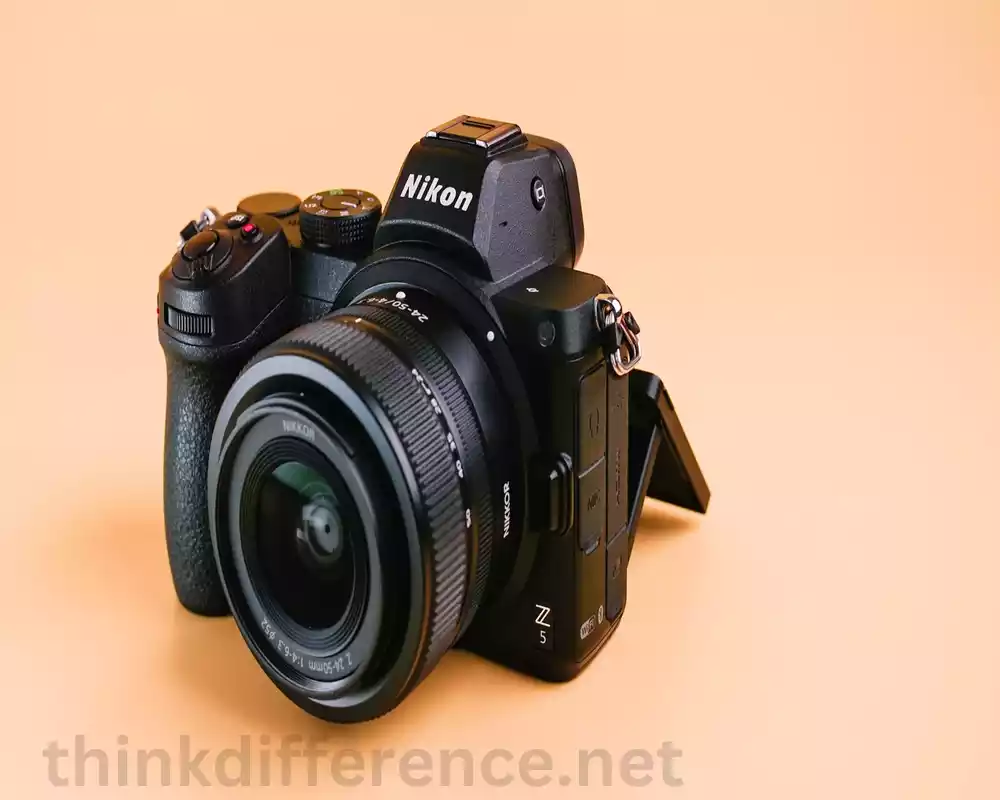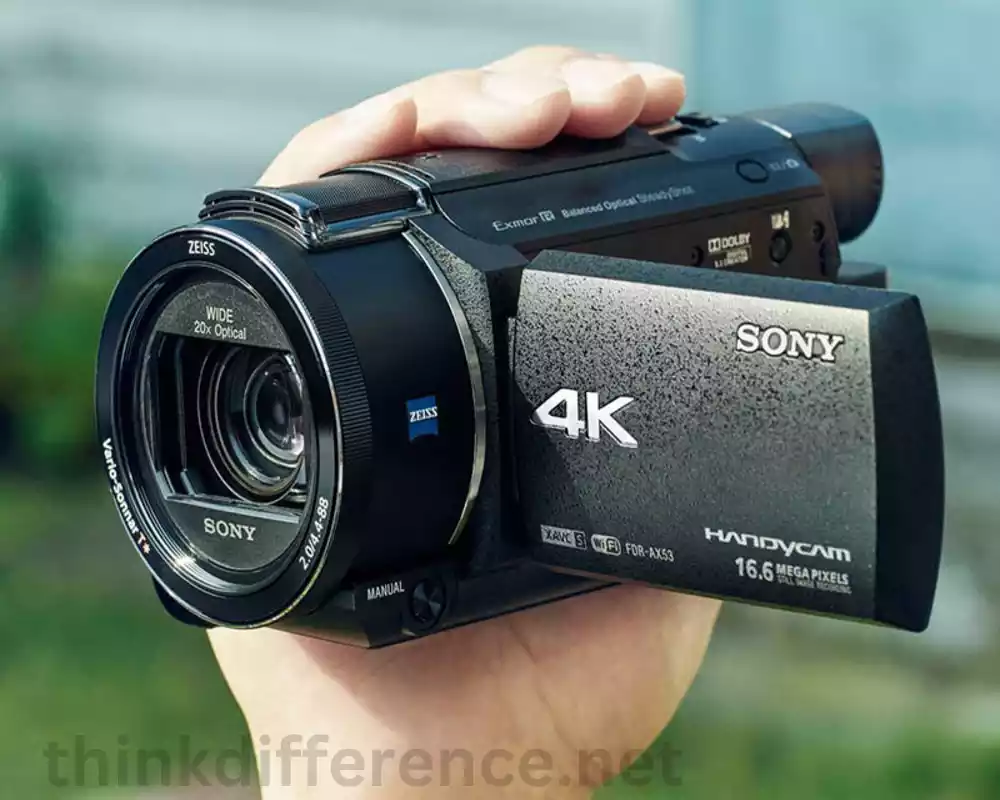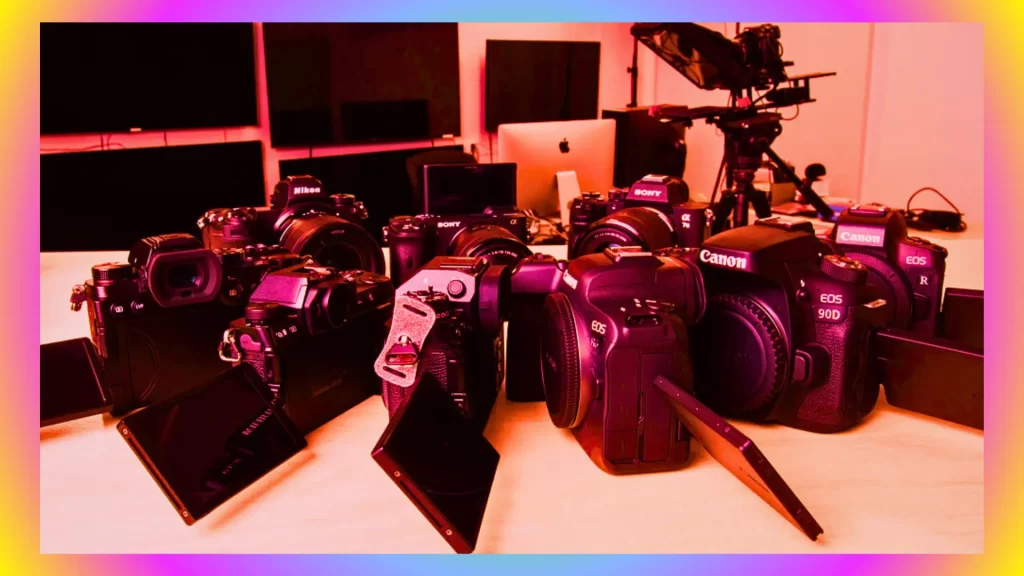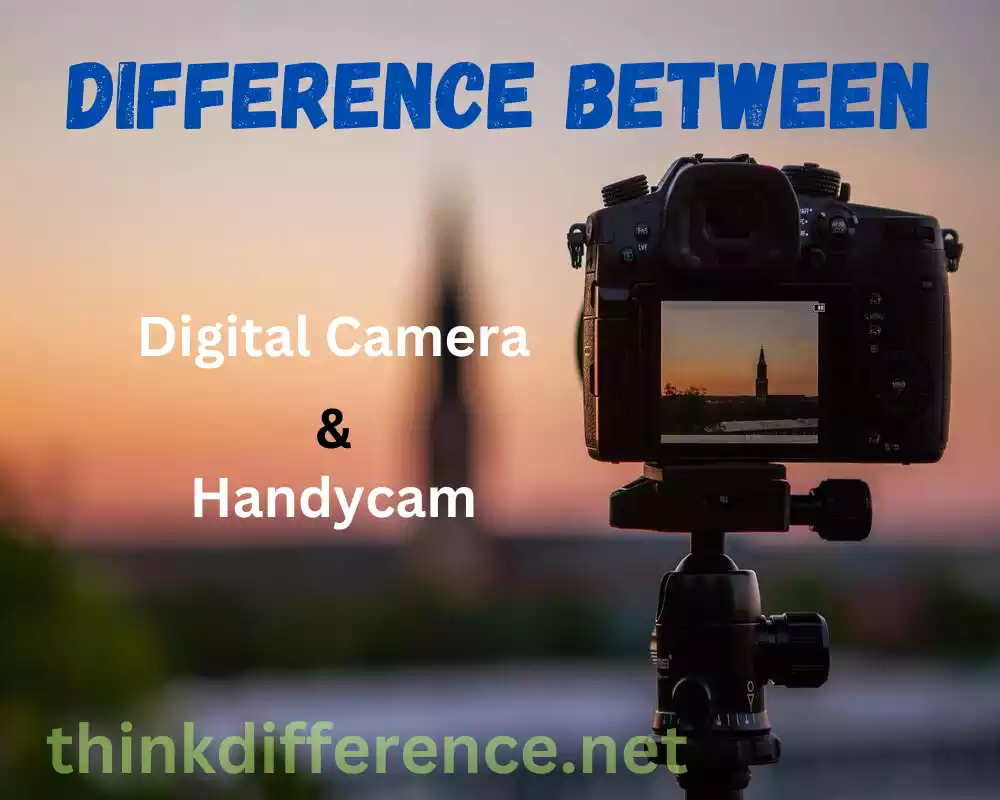Digital Camera and Handycam have transformed how we capture memories. Their convenience, versatility, and image quality has become more prominent over time. In this article we’ll compare both types of cameras’ advantages, features, and distinctions so you can make an informed choice when purchasing one for videography or photography use.
What is a Digital Camera?
Digital cameras are electronic devices used for recording and saving videos and photographs digitally. A CCD (Charge-Coupled Device) or CMOS sensor converts light into electrical signals which are then processed and saved digitally using JPEG format, or alternatively RAW.

Digital cameras feature several key capabilities and features designed to enhance photography experiences, including exposure focus adjustment settings and white balance modification. Various shooting modes (manual, auto aperture priority or shutter priority), image review directly via LCD screen of camera etc.
Digital cameras come in various styles and forms to meet the diverse needs of users, from point-and-shoot models that are small and easy to use, through DSLR (Digital Single Lens Reflex) cameras with interchangeable lenses and more complex manual controls, mirrorless cameras offering both compactness as well as flexibility through interchangeable lenses and more advanced manual controls. The most widely-used types are point-and-shoots (which offer simple point and shoot capabilities), DSLR (Digital Single Lens Reflex), mirrorless, compact point and shoot cameras as well as point & shoot cameras (used primarily).
Digital cameras feature additional features that enhance user experiences, including zoom lenses with image stabilization capabilities and wireless sharing via online or on-demand platforms. With such advanced functions at hand, users are able to capture HD videos and photos under all kinds of lighting conditions and wirelessly share them. These functions enable digital photographers to take HD videos and photos no matter the conditions. Wireless sharing platforms enable easy distribution.
Digital photography cameras have revolutionized photography thanks to their superior flexibility, convenience and image quality when compared to conventional film cameras. Now popular among photographers of all kinds as well as casual users.
Types of Digital Cameras
There are various digital cameras on the market designed to meet specific user requirements and preferences, with popular models including:
- Point-and-Shoot Cameras: Also referred to as camera compacts, lightweight digital compact cameras offer simple operation while remaining lightweight and compact in their construction. They typically have a fixed lens and automatic settings, making them suitable for casual photography and everyday use. Point-and-shoot cameras are popular among beginners and individuals looking for a simple and portable camera option.
- DSLR (Digital Single-Lens Reflex) Cameras: DSLR cameras are favored by photography enthusiasts and professionals who require advanced controls and image quality. They feature a mirror mechanism that reflects light through the lens and into an optical viewfinder, allowing users to see the exact image that will be captured. DSLRs offer interchangeable lenses, manual settings, and various shooting modes, providing greater creative flexibility and control over the final image.
- Mirrorless Cameras: Mirrorless cameras resemble DSLRs in terms of image quality and manual controls. They lack an optical viewfinder or mirror mechanism for image composition or framing purposes. Instead, mirrorless cameras use either electronic viewfinder (EVF) or LCD screens on the camera itself as composition tools and frame images more quickly and precisely than ever. They’re known for being small in size yet lightweight design as well as speedy autofocus performance compared to DSLR cameras. They also feature interchangeable lenses and offer advanced features like 4K video recording and high-speed burst shooting.
- Bridge Cameras: Bridge cameras, also referred to as superzoom or ultrazoom cameras, bridge the gap between point-and-shoot cameras and DSLRs/mirrorless cameras. They have a fixed lens with a wide zoom range, often exceeding the capabilities of other camera types. Bridge cameras boast manual controls and advanced shooting modes as well as higher quality images than point-and-shoot models, making them the ideal option for individuals searching for an all-in-one system camera solution.
- Action Cameras: Action cameras are compact, rugged cameras designed for capturing action-packed moments and adventure activities. They are typically lightweight, waterproof, and shockproof, allowing users to record high-definition videos and take photos in extreme conditions. Action cameras are popular for activities like sports, outdoor adventures, and underwater photography.
- Medium Format Cameras: Medium format cameras are used by professional photographers and those who require the highest possible image quality and resolution. They feature a larger image sensor compared to DSLRs and mirrorless cameras, resulting in exceptional detail, dynamic range, and color reproduction. Medium format cameras are primarily used in commercial, fashion, and landscape photography.
Every type of digital camera offers distinct benefits that suit various shooting scenarios and user preferences, but when choosing an ideal model it is crucial to take into consideration factors like picture quality, mobility, flexibility and price when making this important choice.
Features and Benefits of Digital Cameras
Digital cameras boast many unique advantages that enhance photography experiences, providing several distinct advantages over conventional film cameras.
Below are some key benefits and features offered by these modern tools of photography:
- Instant Preview: Digital cameras allow users to instantly preview captured images on the camera’s LCD screen. This feature enables immediate feedback, allowing users to review and retake shots if necessary, ensuring that they capture the desired image.
- Image Storage and Memory: Digital cameras store images digitally on memory cards, providing ample storage capacity for numerous photos. Users no longer need to carry around rolls of film and can take multiple shots without fearing they may run out before finishing them all up.
- Image Quality and Resolution: Digital cameras offer a wide range of image resolutions, from lower resolutions suitable for web sharing to high resolutions suitable for printing large-format photographs. They also provide control over image quality settings, allowing users to adjust parameters such as ISO sensitivity, white balance, and color profiles to achieve the desired image results.
- Easy Image Transfer: Digital cameras typically come equipped with connectivity options like WI-Fi Bluetooth and USB that make transferring photos to smartphones, computers or printers quick and effortless. This facilitates quick sharing on social media platforms, online galleries, or printing without the need for physical film processing.
- Editing and Post-Processing: Digital cameras allow users to apply various in-camera editing features and filters to enhance or modify images. The digital format allows for extensive post-processing using image editing software on computers, providing greater control over image adjustments, cropping, retouching, and creative effects.
- Flexibility and Versatility: Digital cameras offer a wide range of shooting modes and features to accommodate various photography genres and shooting conditions. Manual controls allow for precise adjustment of focus, exposure and shutter speed adjustments as well as specific shooting modes like panoramic shooting options such as HDR (High Dynamic Range) shooting as well as time-lapse shooting.
- Video Recording: Digital cameras equipped with video recording features allow users to capture both still images and high-definition video recordings simultaneously. Advanced models may offer features like slow motion capture or microphone inputs from external sources for improved audio quality.
- Battery Life: Digital cameras typically use rechargeable batteries, which provide longer-lasting power compared to traditional disposable batteries used in film cameras. This ensures extended shooting sessions without the need to frequently replace batteries.
- Image Organization and Metadata: Digital cameras automatically embed metadata in the image files, including details such as date, time, camera settings, and even geolocation information (if enabled). This simplifies image organization, searchability, and provides useful information for future reference or professional purposes.
- Cost Efficiency: While digital cameras may have an upfront cost, they eliminate the ongoing expenses associated with film, developing, and printing. Users can review and select the images they wish to print, reducing unnecessary printing costs, and enabling more cost-effective photography.
Digital cameras offer numerous features and benefits that make them a popular choice for photographers of all levels. They provide convenience, creative control, instant feedback, and the ability to easily share and edit images, revolutionizing the way we capture and enjoy photography.
What is a Handycam?
A Handycam is a brand name used by Sony Corporation to refer to its line of camcorders or video cameras. A Handycam is designed specifically for capturing high-quality video footage and audio recordings. Portable device which combines video camera and digital recorder features into one.

Handycams are well known for their compact dimensions and user-friendly features that make them suitable for a range of videography requirements. They typically feature a built-in lens, image sensor, microphone, and recording media storage, allowing users to capture video and audio in a single device.
Types of Handycams
Handycams come in various varieties on the market, each tailored to meet specific user preferences and needs.
Here are some popular varieties:
- Standard Handycams: These are the most common type of Handycams, offering a balanced combination of features, size, and affordability. They are suitable for general video recording purposes, ranging from capturing family events to travel videos.
- Action Handycams: Action Handycams are compact and rugged camcorders designed for capturing action-packed moments and extreme sports. They are typically waterproof, shockproof, and equipped with features like image stabilization, wide-angle lenses, and high frame rate recording.
- Professional Handycams: Professional Handycams are high-end camcorders intended for professional videographers and filmmakers. They offer advanced features such as larger image sensors, interchangeable lenses, manual controls, XLR audio inputs, and options for recording in professional formats like 4K or RAW.
- Camcorders with Built-in Projectors: Some Handycams come with built-in projectors, allowing you to project and share your videos instantly without the need for external display devices. This feature can be useful for immediate playback or sharing your recorded content with others.
- 360-Degree Handycams: 360-degree Handycams are designed to capture immersive panoramic videos, allowing viewers to explore the footage from different angles. They typically use multiple lenses to capture a complete spherical view and offer options for virtual reality (VR) playback.
- Compact Handycams: Compact Handycams are lightweight camcorders designed to record moments quickly on-the-go or when mobility is key. Their balanced dimensions, user friendliness, and video quality makes them the ideal companions when recording life’s precious memories.
- Prosumer Handycams: Prosumer Handycams represent an affordable compromise between consumer and professional camcorders, providing superior features at lower costs. They are suitable for users who require higher-quality video recording and more manual controls than standard Handycams but without the higher cost of professional models.
It’s important to note that the availability of specific Handycam types may vary depending on the market and region. It’s recommended to check with reputable retailers or the manufacturer’s website to explore the range of Handycam options available to you.
Features and Benefits of Handycams
Handycams or camcorders boast many attractive features and benefits that make them the go-to solution for high-quality video recording.
Here are a few key characteristics and advantages of Handycams:
- Video Recording Quality: Handycams are designed specifically for video recording, and they provide excellent video quality. They offer various resolutions, including standard definition (SD), high definition (HD), and even 4K Ultra HD in advanced models. This ensures sharp, detailed, and lifelike video footage.
- Optical Zoom: Handycams often come with optical zoom lenses that allow users to zoom in and out smoothly while recording. Optical zoom maintains image quality and allows capturing distant subjects without loss of detail, providing greater flexibility in framing shots.
- Image Stabilization: Handycams incorporate image stabilization technology, which helps to reduce camera shake and produce steady footage. This is especially useful when shooting handheld or in situations with movement, ensuring smoother and more professional-looking videos.
- Audio Quality: Handycams are equipped with built-in microphones or external microphone inputs to capture high-quality audio along with video footage. They may feature technologies such as stereo sound, wind noise reduction, and adjustable audio levels to ensure clear and immersive audio recordings.
- Easy-to-Use Controls: Handycams are designed with user-friendly interfaces and controls, making them easy to operate even for beginners. They typically have intuitive menus, dedicated buttons for essential functions, and touchscreens for convenient navigation and control.
- Compact and Portable: Handycams are lightweight and compact, making them highly portable. They can be easily carried around for on-the-go shooting, allowing users to capture spontaneous moments and events without the need for bulky equipment.
- LCD Screen and Viewfinder: Handycams feature built-in LCD screens that serve as viewfinders and allow users to frame their shots, review recordings, and access various settings and controls. Some models also include electronic viewfinders, which provide an alternative viewing option in bright sunlight or for more precise composition.
- Versatile Shooting Modes: Handycams offer a range of shooting modes to cater to different scenarios and creative preferences. These modes may include options like auto mode for quick and effortless recording, manual mode for precise control over settings, scene modes for optimized settings in specific environments, and creative effects for adding artistic touches to videos.
- Connectivity Options: Handycams typically include connectivity options like USB, HDMI and Wi-Fi that make connecting to TVs, computers or other devices to transmit and receive data or livestream video a simple process. Wi-Fi connectivity may also enable wireless control of the Handycam and the ability to transfer footage directly to smartphones or tablets.
- Battery Life: Handycams use rechargeable batteries that provide sufficient power for extended recording sessions. They are designed to last for a reasonable duration, allowing users to capture videos without worrying about running out of battery power.
- Storage Options: Handycams typically offer various storage options, such as built-in memory, SD cards, or internal hard drives. This allows users to store a large amount of video footage and easily transfer or expand storage as needed.
Handycams provide a dedicated solution for capturing high-quality video footage, offering convenience, ease of use, and advanced features. These cameras are frequently utilized by videographers and creators of content as well as people looking to capture important life experiences or memorable events with an excellent combination of audio quality and video resolution.
Differences between Digital Camera and Handycam

Although digital and handycam cameras share similar goals of recording videos and images, there are a few key differences between the two models that set them apart.
These are some key distinctions between them:
- Design and Form Factor: Digital cameras come in all kinds of models ranging from compact point-and-shoots, DSLRs and mirrorless options – each boasting its own distinctive aesthetics and specifications. Handycams, on the other hand, are specifically designed as camcorders and have a more elongated shape with a built-in handle for comfortable grip and stability during video recording.
- Primary Function: Digital cameras are primarily focused on capturing still photographs, with video recording being a secondary feature. They offer a wide range of features and settings to optimize image quality and creative control. Handycams are designed primarily for video recording, offering features like optical zoom, image stabilization, and audio recording capabilities optimized for capturing high-quality videos.
- Video Recording Capabilities: While some digital cameras do have video recording capabilities, Handycams are specialized for video recording and provide more advanced video features. Handycams typically offer options for different video resolutions, frame rates, and recording formats, including features like optical zoom, image stabilization, and dedicated controls for video settings.
- Audio Recording: Handycams are specifically designed with audio recording in mind, and they often include built-in microphones or external microphone inputs to capture high-quality audio alongside video footage. Digital cameras generally have audio recording capabilities as well, but they may not have the same level of focus on audio quality and control as Handycams.
- Ergonomics and Handling: Handycams are designed with a focus on comfortable handling during video recording, with features like a built-in handle, convenient controls, and an adjustable LCD screen for easy framing. Digital cameras were typically created to record still images. Their ergonomic designs don’t allow for efficient video capture.
- File Storage and Media: Digital cameras typically use memory cards or built-in storage to save images and videos. Handycams, on the other hand, are specifically designed for video recording and often have larger internal storage options or dedicated hard drives to accommodate the larger file sizes associated with video footage.
- Editing and Post-Processing: Both digital cameras and Handycams allow for editing and post-processing of images and videos. However, digital cameras often have more extensive editing features and options for still images, while Handycams may offer specialized editing features for video footage, such as trimming, combining clips, and adding transitions.
- Target Audience and Usage: Digital cameras cater to a broader range of users, including casual photographers, enthusiasts, and professionals, who have diverse photography needs. Handycams, on the other hand, are primarily aimed at users who prioritize video recording, such as videographers, content creators, and individuals who want to capture events and moments primarily through video.
Noting the similarities between digital cameras and Handycams can be misleading as there may be some overlap. Certain cameras offer video recording features while certain handycams offer feature-based still image capture capabilities. But their primary differences lie in design, primary purpose, ability to record both audio/video, ergonomics and target audience considerations.
Price Range and Availability
Prices and availability for handycams and digital cameras will depend upon their model, brand features, as well as where you reside in terms of both model and region of use.
Below are a few general principles:
Digital Cameras:
- Entry-level digital cameras such as compact point and shoot models typically fall between $100-$500 in price range; their features tend to be basic enough for everyday photography needs and provide value.
- Modern compact cameras, mirrorless cameras and DSLRs typically range between $500 and thousands of dollars in terms of cost and feature high image quality, interchangeable lenses with sophisticated controls, professional features such as autofocus capabilities as well as interchangeability of lenses between models.
- Professional cameras of the highest quality may cost anywhere between a few thousand and several thousand dollars, and are generally employed by professional photographers and filmmakers who require top-of-the-line image quality, sturdy build construction and multiple features in their cameras.
Digital cameras are readily accessible, available from electronics stores, camera sellers, marketplaces online and manufacturer websites.
Handycams:
- Entry-level Handycams typically range between $200 and $500 and feature basic video recording functions suitable for casual users.
- Mid-range handycams featuring more advanced features, superior video quality and additional functions typically cost $500-1000.
- Professional-grade Handycams used by filmmakers and videographers typically range in price from around $1,000 up to thousands of dollars, offering top video quality with advanced image stabilization features, top audio input quality inputs, as well as other top-of-the-line features.
Handycams can be purchased in electronics stores, retailers of cameras, online marketplaces and manufacturer websites.
Reminder that prices and availability could change according to sales, discounts or the release of a new product launch. Availability could depend on both where you live and which model interests you. To stay informed regarding current pricing and availability details it’s advisable to inquire with reliable merchants or online platforms in your area or make inquiries directly with them.
How to Choose Between a Digital Camera and a Handycam
Selecting between digital and handycam cameras depends entirely upon your own requirements and photography interests.
Here are a few factors you should keep in mind when making this important decision:
- Primary Purpose: Determine whether your main focus is on capturing still photographs or recording videos. If you prioritize photography and want the flexibility to capture high-quality images in various scenarios, a digital camera would be a suitable choice. If video recording is your primary goal and you require features specifically optimized for video, such as optical zoom, image stabilization, and audio recording capabilities, then a Handycam would be more appropriate.
- Image Quality: Consider the level of image quality you desire. Digital cameras, especially advanced models such as DSLRs or mirrorless cameras, generally offer higher resolution sensors, larger image sensors, and interchangeable lenses, providing superior image quality and creative control compared to Handycams.
- Video Quality: If video recording is crucial to your needs, Handycams are designed specifically for video capture and often offer advanced video recording features like optical zoom, image stabilization, and dedicated controls. Handycams may support higher resolutions and frame rates, making them more suitable for professional or high-quality video production compared to digital cameras that may have video recording as a secondary feature.
- Portability and Convenience: Consider how portable and convenient you need your device to be. Digital cameras come in all sorts of shapes and sizes, from point-and-shoot models to full frame DSLRs. Handycams are designed to be portable and often have a built-in handle for comfortable grip during video recording. If you need a compact and lightweight option for travel or spontaneous photography, a digital camera might be more suitable. If you prioritize handheld video recording and ease of use, a Handycam’s form factor may be more convenient.
- Versatility: Evaluate the range of features and shooting modes that each device offers. Digital cameras often provide a broader range of creative options, manual controls, and shooting modes suitable for different photography genres. Handycams may offer specialized video features, such as slow motion, time-lapse, or built-in filters, that are optimized for video recording.
- Budget: Consider your budget and the cost associated with each option. Digital cameras come at various price points and levels of quality. From entry-level models to professional high-end versions and include options that meet both budget requirements and photographic preferences. Handycams are generally priced competitively and provide a dedicated solution for video recording. Evaluate the features and capabilities you require within your budget range.
- Future Growth and Expansion: Consider your long-term goals and whether you anticipate expanding your photography or videography skills. Digital cameras often offer more opportunities for growth and learning, as they allow for interchangeable lenses, advanced manual controls, and compatibility with a wide range of accessories. If you foresee a need for more advanced photography techniques or exploring different genres, a digital camera may offer more flexibility.
Selecting between digital cameras or Handycams depends upon determining your primary goals, the content that needs creating, the desired level of flexibility and quality, as well as any user reviews of various types that exist – it would also help if possible trying some out before making a final decision.
Tips for Using Digital Cameras and Handycams
Here are some tips for using digital cameras and Handycams effectively:
Tips for Using Digital Cameras:
- Read the Manual: By reading the user’s manual of your camera, familiarizing yourself with its specific features and functions will allow you to fully maximize its capabilities. Understanding how the features work will allow for greater user control when setting it up or changing settings on it.
- Discover the Basics: Gaining knowledge of photography basics such as exposure, aperture, shutter speed and ISO will equip you to have more control of your camera and produce more impressive images. By having greater command of these elements of photography you will produce better results from it.
- Use Appropriate Shooting Modes: Digital cameras often offer various shooting modes such as auto, aperture priority, shutter priority, and manual mode. Experiment with different modes to understand their effects and choose the one that best suits the shooting situation.
- Composition and Framing: Pay attention to composition and framing when taking photos. Utilize techniques like the rule of thirds, leading lines, and depth of field to create visually appealing images.
- Experiment with White Balance: White balance settings help capture accurate colors in different lighting conditions. Try different white balance presets or adjust it manually to achieve the desired color tones.
- Utilize Autofocus Points: Utilize the autofocus points available on your digital camera. Selecting the appropriate focus point allows you to precisely focus on your subject and create sharper images.
- Consider RAW Format: If your camera supports it, consider shooting in RAW format. RAW files retain more image data, providing greater flexibility during post-processing for adjusting exposure, white balance, and other parameters.
- Explore Accessories: Explore accessories such as additional lenses, external flashes, tripods, and remote shutter releases to expand your creative possibilities and overcome limitations in certain shooting scenarios.
Tips for Using Handycams:
- Stabilize Your Shots: To achieve smooth and stable video footage, use proper stabilization techniques. Hold the Handycam with both hands, keep your arms close to your body, and utilize built-in image stabilization features when available.
- Understand Zooming: Handycams often offer optical zoom capabilities. Experiment with different zoom levels to frame your shots effectively, but be cautious with excessive zoom as it can introduce camera shake and affect video quality.
- Use a Tripod or Monopod: When stability is crucial or for longer recording sessions, consider using a tripod or monopod. These accessories provide steady support, reduce camera shake, and allow you to maintain focus on your subject.
- Audio Considerations: Pay attention to audio quality when recording videos. Position the Handycam’s built-in microphone or an external microphone close to the sound source to capture clear and high-quality audio. Use windshields or wind socks to minimize wind noise during outdoor recordings.
- Practice Smooth Panning and Tracking: When following moving subjects or panning across a scene, practice smooth camera movements to maintain a professional and visually pleasing video. Avoid jerky or abrupt movements that can distract viewers.
- Plan Your Shots and Sequences: Before recording, plan your shots and sequences to ensure a coherent and well-structured video. Consider the framing, angles, transitions, and storytelling aspects to capture compelling footage.
- Monitor Battery Life: Handycams rely on battery power, so keep an eye on battery levels and have spare batteries or a charging solution available to avoid interruptions during recording sessions.
- Explore Video Editing: After capturing your video footage, utilize video editing software to enhance and refine your recordings. Edit out unwanted segments, add transitions, apply color correction, and incorporate audio enhancements to create a polished final product.
Remember, practice is key to improving your skills with both digital cameras and Handycams. Experiment with different settings, techniques, and shooting conditions to develop your style and achieve the desired results.
Conclusion
Digital cameras and Handycams have indubitably transformed the world of photography and videography. With their advanced technology, convenience, and versatility, these devices have become an indispensable part of our lives, allowing us to capture and relive memories like never before.



